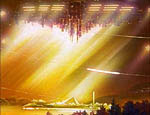FGC:Supplemental (Geofront Geometry)
Jump to navigation
Jump to search
Episode #01: Geofront Geometry
(Expanded Commentary from C-168)
MDWigs: The Geofront is a sphere with a diameter of 13.75 km). However, 89% of it is buried and only the top part (900 m high and 6 km across) is open. I'm not sure if those figures are internally consistent; using geometry, you can work out if a sphere with a diameter of 13.75 km can be intersected to produce a top section 6 km across and 900 m high, and that could also be checked with the 89% figure.

Mr. Tines: The figures aren't at all consistent, I'm afraid. Dusting off the high-school maths, we have:
- Center of sphere to top of sphere = radius of sphere = 6.875 km (by definition)
- Top of sphere to Geofront ground level = 0.900 km
- Centre of sphere to where Geofront ground level touches = radius of sphere = 6.875 km (by definition)
- Centre of sphere to Geofront ground level = 5.975 km
- There is a right angle triangle centre of sphere/Geofront ground level above centre (where the right angle is)/ground level touches sphere.
- So Pythagoras gives 6.875² = 5.975² + (radius of geofront ground level)², i.e.
- 47.265625 = 35.700625 + radius²
- rearranging gives radius² = 11.565 or radius = 3.4 km, so the Geofront void would be nearer 7km across for the 900m maximum height.
- 47.265625 = 35.700625 + radius²
- The open volume, V = (π/3) height² (3*radius - height) = 0.848 * (3*6.875 - 0.9)
- =16.7 cubic km, which is under 2% of the volume of the sphere, which is about 98%, not 89% filled up. The other almost 10% of the volume must go into all the other large underground chambers we see.
The quoted figures mean that Eva geometry is as rubber as the physics (not that it really matters). This page tells you all you might want to know about the geometry of something like the Geofront.

